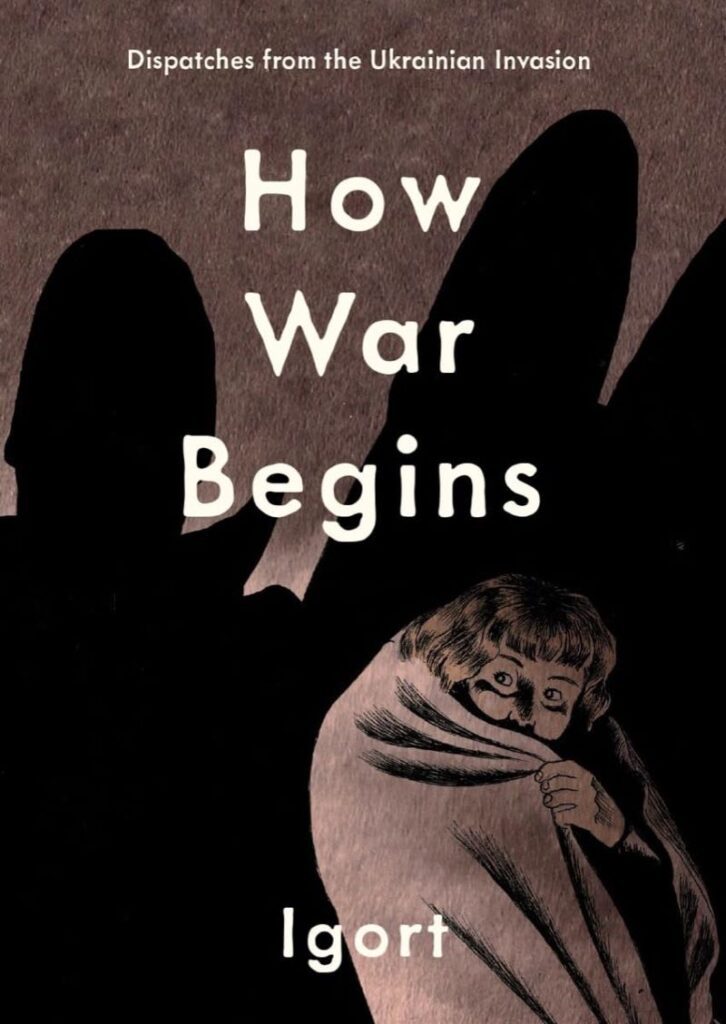
Italian cartoonist Igort began serializing reports from Ukrainian citizens in the early days of their ongoing invasion by Russian forces. Two years later, those powerful testimonies have been collected in this new hardcover book. Although the compiled work is more illustrated journalism than conventional graphic novel, Igort’s efforts drive home the senselessness of Putin’s actions by getting down to a granular level of personal suffering not usually present in overview news updates.
Buy How War Begins: Dispatches from the Ukrainian Invasion by IgortRather than follow the ongoing struggles of a few Ukrainian citizens, Igort relies on brief vignettes from a large rotating group of individuals. This provides greater scope of the war’s impact, but doesn’t allow readers to build connections with the continuing stories of principal participants. Everyone has a story to tell, but with so many players it’s confusing to keep track of any of them, so it quickly becomes evident that we should focus solely on the wartime tales, not their narrators.
Igort’s book stops at day 80 of the Russian invasion, with the pages laid out in roughly chronological order except for two eye-opening dips into the past. In the first, he takes us back to 2014 to reveal that Russian armed forces have been deployed in Ukraine for 10 years now, not just two. He traces the roots of Putin’s plans for the country in engrossing detail, providing information that seems to have been glossed over or completely forgotten by Western media. In the other, he goes back even further to a devastating famine in Ukraine instigated by Stalin between 1932-33. Stalin’s genocidal plan wiped out 6-10 million Ukrainians and transferred millions more to Siberia, and yet most of us remain blissfully unaware of the tragedy.
This brings up a recurring theme of Igort’s book: his firm belief that Western governments and media continue to turn a blind eye to Russia’s decades of ruthless imperialism, content to sit on their thumbs as long as Russia isn’t coming after them. He never gets overly venomous about his disgust, but his book is his attempt at a call to arms for the sleeping giants who are failing to recognize the full extent of Russia’s dangerous ambitions.
The closest comparison to Igort’s work here is of course Joe Sacco’s lengthy career of journalistic cartooning in troubled spots around the world. However, where Sacco has always been very much hands on in his books such as Palestine (soon to be republished by Fantagraphics), putting himself in harm’s way for extended times to get a true sense of the lives of his subjects, Igort is removed from the war zone. He’s simply reporting what he learns during telephone calls with Ukrainian citizens, keeping his subjects at arm’s length as he works from the security of his home. This distance impacts the work a bit, as his lack of physical presence on the scene keeps him from offering his own personal insight or vetting story details. He’s more news anchor than field reporter, with a corresponding measure of detachment from the action.
The book is text heavy, to the extent that full text pages occasionally pass by without illustration. Igort has a lot of second-hand information to pass along, and chooses to tell it more often than show it. His art is mostly static images of people and places, like postcards from the front, rather than kinetic depictions of tragedy. Word balloons are used sparingly, with only a few brief sequences that follow typical comic standards. His coloring maintains somber tones to match the downbeat material, slipping into sepia shades for one flashback and black and white for the other. His skillfully crafted art is evocative without being overly showy, exhibiting a variety of styles and techniques to enhance the book’s visual appeal.
Igort’s book is a valuable resource for harrowing personal anecdotes about current life in Ukraine. It’s highly educational, especially the historical background lacking in our general knowledge. While the nature of its ongoing subject precludes a satisfying conclusion, it is a fascinating and insightful look at civilian perseverance in an active war zone.
How War Begins: Dispatches from the Ukrainian Invasion is available beginning March 26th.